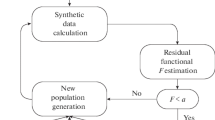Abstract
The extensive application of pre-stack depth migration has produced huge volumes of seismic data, which allows for the possibility of developing seismic inversions of reservoir properties from seismic data in the depth domain. It is difficult to estimate seismic wavelets directly from seismic data due to the nonstationarity of the data in the depth domain. We conduct a velocity transformation of seismic data to make the seismic data stationary and then apply the ridge regression method to estimate a constant seismic wavelet. The estimated constant seismic wavelet is constructed as a set of space-variant seismic wavelets dominated by velocities at different spatial locations. Incorporating the weighted superposition principle, a synthetic seismogram is generated by directly employing the space-variant seismic wavelets in the depth domain. An inversion workflow based on the model-driven method is developed in the depth domain by incorporating the nonlinear conjugate gradient algorithm, which avoids additional data conversions between the time and depth domains. The impedance inversions of the synthetic and field seismic data in the depth domain show good results, which demonstrates that seismic inversion in the depth domain is feasible. The approach provides an alternative for forward numerical analyses and elastic property inversions of depth-domain seismic data. It is advantageous for further studies concerning the stability, accuracy, and efficiency of seismic inversions in the depth domain.
Similar content being viewed by others
References
Biancol, E., 2016, Tutorial: Wavelet estimation for well ties: The Leading Edge, 35(6), 541–543.
Claerbout, J. F., 1985, Imaging the Earth’s Interior: Blackwell Science Inc, Oxford, 83–89.
Fatti, J. L., Smith, G. C., Vail, P. J., et al., 1994, Detection of gas in sandstone reservoirs using AVO analysis: A 3-D seismic case history using the Geostack technique: Geophysics, 59(9), 1362–1376.
Fletcher, R. P., Archer, S., Nichols, D., et al., 2012, Inversion after depth imaging, 82th Annual International Meeting, SEG, Expanded Abstracts, 1–5.
Golub, G. H., Heath, M. T., and Wahba, G., 1979, Generalized cross-validation as a method for choosing a good ridge parameter: Technometrics, 21(2), 215–223.
Hao, X., 2006, Research on seismic wave amplitude AVA inversion method: MS Thesis, Tongji University, Shanghai.
Hoerl, A. E., and Kennard, R. W., 1970, Ridge regression: biased estimation for non-orthogonal problem: Technometrics, 12(1), 55–67.
Hu, Z., Zhu, H., Lin, B., et al., 2007, Wavelet analysis and convolution in depth domain: 77th Annual International Meeting, SEG, Expanded Abstracts, 2733–2737.
Letki, L. P., Tang, J., and Du, X., 2015, Depth domain inversion case study in complex subsalt area: 77th EAGE Annual Meeting, Expanded Abstracts, We N104 12.
Lin, B. X., Hu, Z. P., and Xue, S. G., 2006, Using velocity function in transformed depth domain to make synthetic seismograph in depth domain: Oil Geophysical Prospecting (in Chinese), 41(6), 640–643.
Ma, X. Q., 2001, A constrained global inversion method using an overparameterized scheme: Application to poststack seismic data: Geophysics, 66(2), 613–626.
Ma, X. Q., 2002, Simultaneous inversion of prestack seismic data for rock properties using simulated annealing: Geophysics, 67(6), 1877–1885.
Margrave, G. F., 1998, Theory of nonstationary linear filtering in the Fourier domain with application to time variant filtering: Geophysics, 63(1), 244–259.
Press, W. H., Teukolsky, S. A., Vetterling, W. T., et al., 1992, Numerical recipes in C: Cambridge University Press, Cambridge, 400–405.
Richardson, L. F., and Gaunt, J. A., 1927, The deferred approach to the limit. Part I. Single lattice. Part II. Interpenetrating Lattices: Philosophical Transactions of the Royal Society of London, Series A, 226(636–646), 299–361.
Singh, Y., 2012, Deterministic inversion of seismic data in the depth domain: The Leading Edge, 31(5), 538–545.
Zhang, X., Liang, F., and Wang, G., 2000, A method for synthesizing seismogram in depth domain: Oil Geophysical Prospecting (in Chinese), 35(3), 377–380, 385.
Zhang, R., Zhang, K., and Alekhue, J. E., 2017, Depth-domain seismic reflectivity inversion with compressed sensing technique: Interpretation-A Journal of Subsurface Characterization, 5(1), T1–T9.
Zhang, R., and Deng, Z., 2018, A depth variant seismic wavelet extraction method for inversion of poststack depth-domain seismic data: Geophysics, 83(6), R569–R579.
Zheng, L., 2009, Study on several conjugate gradient methods: MS Thesis, Chongqing University, Chongqing.
Acknowledgements
The authors appreciate Data Processing Company, Geophysical-China Oilfield Services Limited for providing data for this study. The authors would like to extend their sincere thanks to Professors He Bingshou and Liu Yang for their guidance and comments to improve this manuscript.
Author information
Authors and Affiliations
Corresponding author
Additional information
This study was supported by the National Natural Science Foundation of China (No. 41574130, 41874143 and 41374134), the National Science and Technology Major Project of China (No. 2016ZX05014-001-009) and the Sichuan Provincial Youth Science & Technology Innovative Research Group Fund (No. 2016TD0023).
Jiang Wei received his bachelor and master degrees in geophysics in 2013 and 2018. respectively, from the Chengdu University of Technology. He is presently a Ph.D. student at the Chengdu University of Technology, majoring in geophysical prospecting and information technology. His main research interests are pre-stack seismic inversion and the numerical modeling.
Rights and permissions
About this article
Cite this article
Jiang, W., Chen, X.H., Zhang, J. et al. Impedance inversion of pre-stack seismic data in the depth domain. Appl. Geophys. 16, 427–437 (2019). https://doi.org/10.1007/s11770-019-0791-0
Received:
Revised:
Published:
Issue Date:
DOI: https://doi.org/10.1007/s11770-019-0791-0




